The Petri Dishes Market is estimated to be valued at USD 473.1 million in 2025 and is projected to reach USD 728.4 million by 2035, registering a compound annual growth rate (CAGR) of 4.4% over the forecast period.
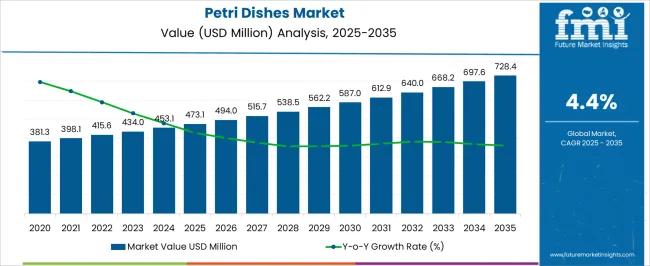
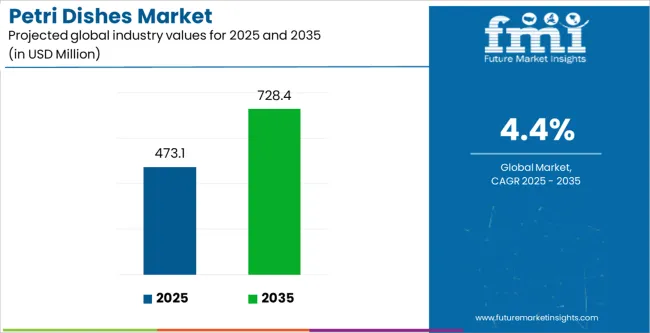
| Metric | Value |
|---|---|
| Petri Dishes Market Estimated Value in (2025 E) | USD 473.1 million |
| Petri Dishes Market Forecast Value in (2035 F) | USD 728.4 million |
| Forecast CAGR (2025 to 2035) | 4.4% |
The Petri Dishes market is experiencing consistent growth, driven by its critical role in microbiological studies, cell culture applications, and diagnostic testing. The current market landscape reflects rising demand from clinical laboratories, pharmaceutical research centers, and academic institutions as global investment in healthcare research expands. The increasing prevalence of infectious diseases, heightened focus on antimicrobial resistance, and the rise of biopharmaceutical development have created significant demand for reliable and standardized culture platforms.
In addition, ongoing innovations in laboratory automation and the need for disposable culture materials to minimize contamination risks are supporting market expansion. The future outlook remains favorable as personalized medicine, drug discovery, and advanced diagnostic practices continue to grow, necessitating precision in microbial and cellular studies.
Expanding healthcare infrastructure in developing regions and the scaling up of R&D expenditure in developed markets are also expected to accelerate adoption With a balanced combination of clinical relevance and manufacturing innovation, the Petri Dishes market is anticipated to achieve stable growth across both established and emerging geographies.
The petri dishes market is segmented by end use, material, and geographic regions. By end use, petri dishes market is divided into Microbiology, Chemical, Bio-chemical, Nanotechnology, Pharmaceutical, and Other Applications. In terms of material, petri dishes market is classified into Plastic, Glass, and Other Materials. Regionally, the petri dishes industry is classified into North America, Latin America, Western Europe, Eastern Europe, Balkan & Baltic Countries, Russia & Belarus, Central Asia, East Asia, South Asia & Pacific, and the Middle East & Africa.

The microbiology segment is expected to account for 48.50% of the Petri Dishes market revenue in 2025, making it the leading end use category. This dominance has been driven by the central role of microbiology in healthcare diagnostics, pharmaceutical research, food safety testing, and environmental monitoring. Petri dishes are widely used to cultivate, isolate, and identify microorganisms, and the increasing need for accurate detection of pathogens has reinforced their importance.
Growing concern about infectious disease outbreaks and rising demand for antimicrobial resistance surveillance are fueling reliance on microbiological testing. The segment has also benefited from continuous academic research activity and government funding directed at microbiological studies.
In addition, the surge in biotechnology innovations and vaccine development has strengthened the application of Petri dishes in microbial culture workflows As laboratory practices evolve toward automation and higher throughput, microbiology-focused applications are expected to remain dominant, supported by the indispensable role of Petri dishes in ensuring accuracy, reproducibility, and reliability of microbial research and diagnostic outcomes.
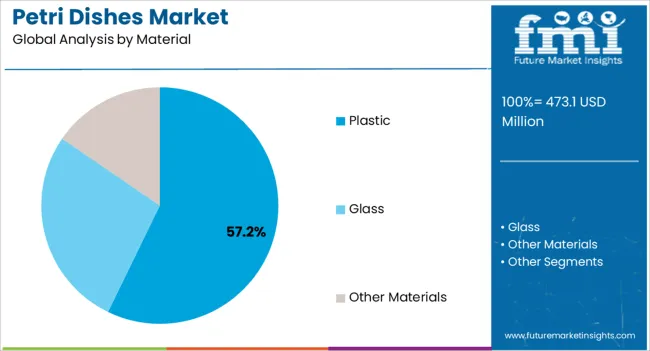
The plastic segment is projected to contribute 57.20% of the Petri Dishes market revenue in 2025, establishing it as the leading material type. This growth has been attributed to the advantages of plastic dishes, including cost efficiency, disposability, and reduced risk of contamination compared to reusable glass alternatives. Plastic Petri dishes are widely preferred in laboratories where single use items are necessary to maintain sterile conditions, making them highly suitable for large scale testing environments.
The segment has gained traction with the increasing demand for high volume culture work in pharmaceutical and diagnostic laboratories. Manufacturing innovations that enable consistent quality, optical clarity, and compatibility with automated laboratory equipment have further supported adoption.
Moreover, the growing emphasis on biosafety and the need to minimize cross contamination risks in clinical and research applications have strengthened the preference for plastic dishes With laboratory practices moving toward sustainable yet efficient consumable solutions, the plastic segment is expected to maintain leadership due to its practicality, scalability, and widespread acceptance in diverse end use settings.
Cell culture dishes, commonly referred to as petri dishes or petri dishes, are shallow cylindrical glass dishes or lidded plastic dishes used by biologists and other laboratory personnel to study and culture cells. Petri dishes are incorporated as temporary receptacles used for studying samples and specimen under low powered microscopes.
Today, manufacturers offer petri dishes that feature slots and/or rings on their bases and lids to make them less prone to sliding off one another, when stacked together. Multiple petri dishes can be placed in a plastic container to create a multi-well plate. Plastic petri dishes are usually disposed after use to ensure that the cellular cultures do not contaminate each other.
However, glass petri dishes can be sterilized and reused via an autoclave set at 121oC for 15 to 20 minutes while using the moist heat sterilization process. Such glass petri dishes may be dry heated for 60 minutes in a hot air oven set at 160oC.
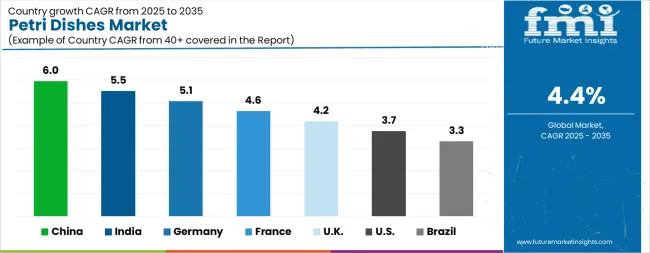
| Country | CAGR |
|---|---|
| China | 6.0% |
| India | 5.5% |
| Germany | 5.1% |
| France | 4.6% |
| U.K. | 4.2% |
| U.S. | 3.7% |
| Brazil | 3.3% |
The Petri Dishes Market is expected to register a CAGR of 4.4% during the forecast period, exhibiting varied country level momentum. China leads with the highest CAGR of 6.0%, followed by India at 5.5%. Developed markets such as Germany, France, and the U.K. continue to expand steadily, while the U.S. is likely to grow at consistent rates. Brazil posts the lowest CAGR at 3.3%, yet still underscores a broadly positive trajectory for the global Petri Dishes Market. In 2024, Germany held a dominant revenue in the Western Europe market and is expected to grow with a CAGR of 5.1%. The U.S. Petri Dishes Market is estimated to be valued at USD 178.6 million in 2025 and is anticipated to reach a valuation of USD 258.0 million by 2035. Sales are projected to rise at a CAGR of 3.7% over the forecast period between 2025 and 2035. While Japan and South Korea markets are estimated to be valued at USD 25.5 million and USD 13.4 million respectively in 2025.
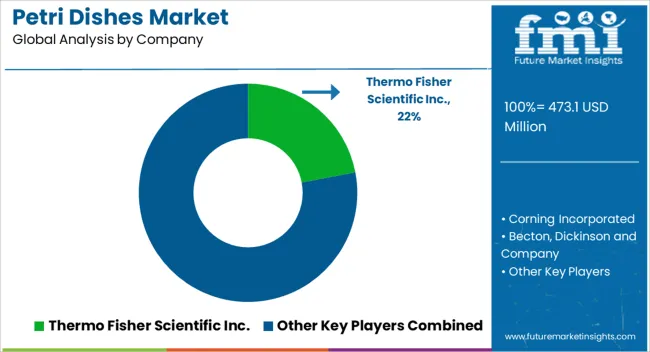
| Item | Value |
|---|---|
| Quantitative Units | USD 473.1 Million |
| End Use | Microbiology, Chemical, Bio-chemical, Nanotechnology, Pharmaceutical, and Other Applications |
| Material | Plastic, Glass, and Other Materials |
| Regions Covered | North America, Europe, Asia-Pacific, Latin America, Middle East & Africa |
| Country Covered | United States, Canada, Germany, France, United Kingdom, China, Japan, India, Brazil, South Africa |
| Key Companies Profiled | Thermo Fisher Scientific Inc., Corning Incorporated, Becton, Dickinson and Company, and Greiner Bio-One International GmbH |
The global petri dishes market is estimated to be valued at USD 473.1 million in 2025.
The market size for the petri dishes market is projected to reach USD 728.4 million by 2035.
The petri dishes market is expected to grow at a 4.4% CAGR between 2025 and 2035.
The key product types in petri dishes market are microbiology, chemical, bio-chemical, nanotechnology, pharmaceutical and other applications.
In terms of material, plastic segment to command 57.2% share in the petri dishes market in 2025.






Our Research Products

The "Full Research Suite" delivers actionable market intel, deep dives on markets or technologies, so clients act faster, cut risk, and unlock growth.

The Leaderboard benchmarks and ranks top vendors, classifying them as Established Leaders, Leading Challengers, or Disruptors & Challengers.

Locates where complements amplify value and substitutes erode it, forecasting net impact by horizon

We deliver granular, decision-grade intel: market sizing, 5-year forecasts, pricing, adoption, usage, revenue, and operational KPIs—plus competitor tracking, regulation, and value chains—across 60 countries broadly.

Spot the shifts before they hit your P&L. We track inflection points, adoption curves, pricing moves, and ecosystem plays to show where demand is heading, why it is changing, and what to do next across high-growth markets and disruptive tech

Real-time reads of user behavior. We track shifting priorities, perceptions of today’s and next-gen services, and provider experience, then pace how fast tech moves from trial to adoption, blending buyer, consumer, and channel inputs with social signals (#WhySwitch, #UX).

Partner with our analyst team to build a custom report designed around your business priorities. From analysing market trends to assessing competitors or crafting bespoke datasets, we tailor insights to your needs.
Supplier Intelligence
Discovery & Profiling
Capacity & Footprint
Performance & Risk
Compliance & Governance
Commercial Readiness
Who Supplies Whom
Scorecards & Shortlists
Playbooks & Docs
Category Intelligence
Definition & Scope
Demand & Use Cases
Cost Drivers
Market Structure
Supply Chain Map
Trade & Policy
Operating Norms
Deliverables
Buyer Intelligence
Account Basics
Spend & Scope
Procurement Model
Vendor Requirements
Terms & Policies
Entry Strategy
Pain Points & Triggers
Outputs
Pricing Analysis
Benchmarks
Trends
Should-Cost
Indexation
Landed Cost
Commercial Terms
Deliverables
Brand Analysis
Positioning & Value Prop
Share & Presence
Customer Evidence
Go-to-Market
Digital & Reputation
Compliance & Trust
KPIs & Gaps
Outputs
Full Research Suite comprises of:
Market outlook & trends analysis
Interviews & case studies
Strategic recommendations
Vendor profiles & capabilities analysis
5-year forecasts
8 regions and 60+ country-level data splits
Market segment data splits
12 months of continuous data updates
DELIVERED AS:
PDF EXCEL ONLINE

Thank you!
You will receive an email from our Business Development Manager. Please be sure to check your SPAM/JUNK folder too.
Chat With
MaRIA